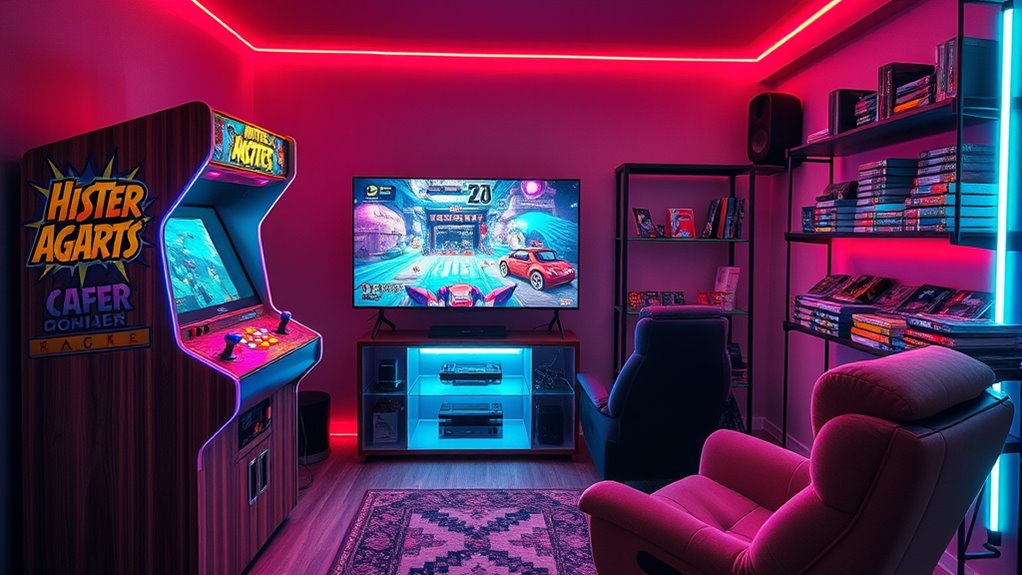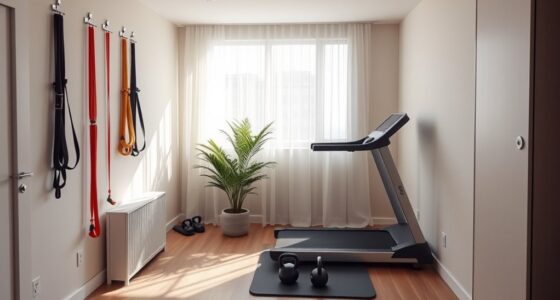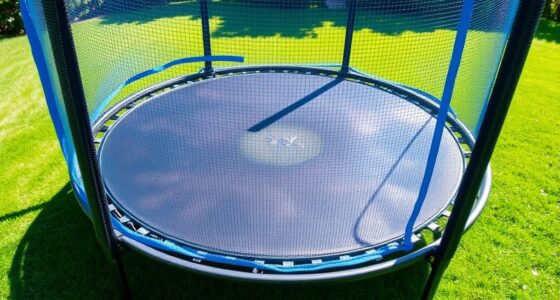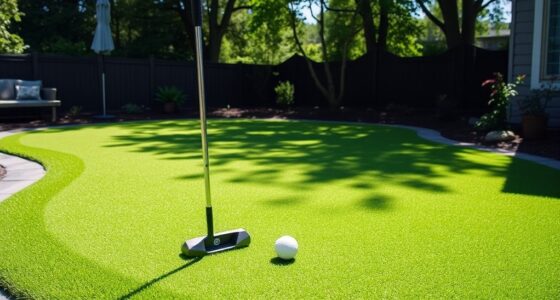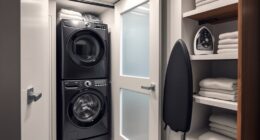Setting up a home arcade is a fun project that combines custom cabinets, consoles, and modern hardware. You can choose between DIY MDF or prefabricated cabinets, or even portable bartop models. Pair a high-quality display and speakers with reliable control systems like Raspberry Pi or PC setups. Proper space, sound management, and wiring are essential for a seamless experience. Keep exploring to discover tips on making your arcade functional, stylish, and personalized to your gaming style.
Key Takeaways
- Choose between DIY or prefabricated arcade cabinets based on skill, budget, and customization preferences.
- Select appropriate display and audio components to ensure immersive gameplay and multi-use functionality like a jukebox.
- Plan room size, flooring, and space layout for stable setup, accessibility, and optimal player comfort.
- Implement sound isolation and centralized power management with smart strips to reduce household noise and simplify operation.
- Customize control systems with modular wiring and button layouts, connecting to PCs or Raspberry Pi for versatile gaming options.
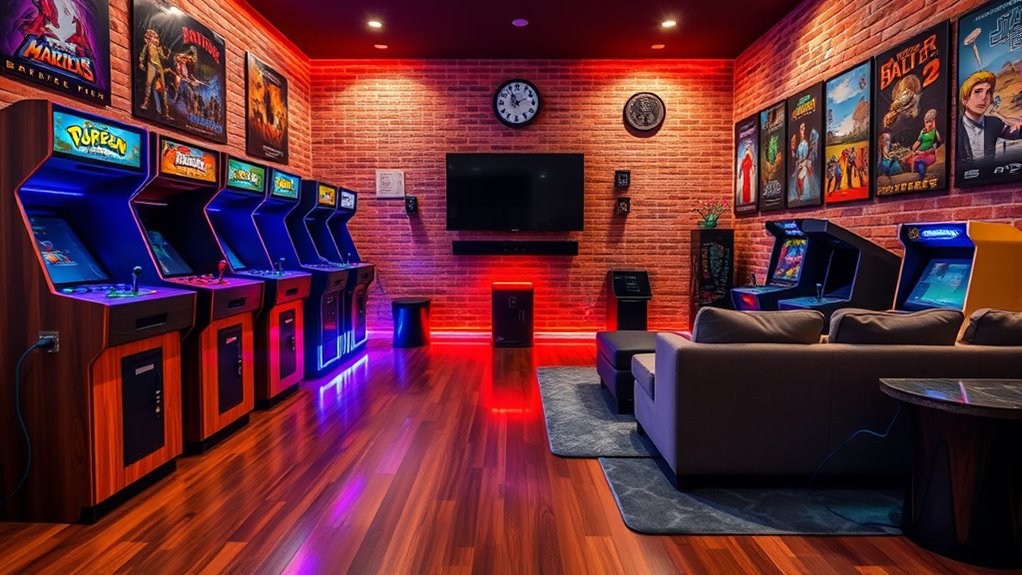
Are you ready to create your own home arcade? Building a personal arcade space might seem daunting at first, but with proper planning, it becomes an achievable and rewarding project. The first step involves understanding your space requirements. A standard arcade cabinet typically needs a room that measures about 72 by 74 centimeters with a height of 181.5 centimeters. This guarantees enough room for comfortable gameplay and cabinet placement. Equally important is having level and stable flooring; uneven surfaces can cause cabinets to tilt or sustain damage during intense play sessions. Keep in mind that arcade cabinets often weigh around 88 kilograms, so handling them alone can be tricky. Having a second person to assist during setup makes the process safer and easier. Proper space planning ensures that your arcade remains functional and accessible, making the gaming experience more enjoyable. Sound is another essential aspect of your home arcade. If you plan to use large speakers or subwoofers, consider sound isolation measures to prevent noise from disturbing others in your household. Smart power strips come in handy here, allowing you to control the monitor, marquee lights, and sound system from a single PC’s power button, simplifying operation and reducing clutter. As you move into construction, you’ll decide whether to build your cabinets from scratch or purchase prefabricated units. DIY cabinets typically involve MDF panels, 3D-printed parts, and structural adhesives, giving you complete control over design and authenticity. For a compact solution, portable bartop cabinets made from monitor shipping boxes work well and are easy to assemble. Prefabricated options are available and require minimal assembly, perfect if you’re short on time. Display and audio components are essential for immersive gameplay. A 26- to 27-inch LCD monitor offers an ideal size for modern setups, providing clarity and vibrant visuals. Display quality is crucial for an engaging experience, especially when combined with high-quality graphics hardware. Speakers and subwoofers should be selected for good sound quality, especially since your arcade might double as a jukebox. Mounting speakers above pre-cut holes in the cabinet with screws or adhesive ensures clear audio delivery. For aesthetic appeal, some modify speaker grills or keep them for a vintage look. Control systems are fundamental for authentic gameplay, with popular options including arcade control distributors like Suzo-Happ and Ultimarc. Connecting buttons and joysticks to a PC or Raspberry Pi involves I-PAC controllers and proper wiring, with modular control panels allowing customization of button layouts—typically 2 to 6 buttons per game. Hardware platforms vary from Raspberry Pi with RetroPie OS, supporting over 50 gaming platforms and thousands of ROMs, to more powerful PCs capable of running modern emulators and high-end graphics. Using emulators like Final Burn Alpha simplifies ROM management and controller setup. Wiring begins with grounding, then connecting each button and joystick carefully to guarantee reliable operation. The entire build process demands attention to detail, from securing the cabinet to wiring and testing electrical safety. With patience and precision, you’ll soon have a home arcade that delivers authentic gaming experiences right in your living space.
Frequently Asked Questions
What Are the Best Space-Saving Home Arcade Options?
You’re looking for the best space-saving home arcade options, and there are plenty to choose from. Wall-mounted units free up floor space, while compact cabinets and slim designs maximize gameplay in small rooms. Console-style and portable options offer flexibility and easy storage, perfect for tight spots. DIY kits let you customize and build your own arcade on a budget. These choices help you enjoy arcade gaming without sacrificing your limited space.
How Do I Connect Modern Consoles to Arcade Cabinets?
To connect modern consoles to arcade cabinets, you typically use adapter boards or microcontroller-based interfaces that translate signals between the console and arcade controls. Rewire your buttons and joysticks or use commercial adapters for plug-and-play compatibility. Make certain your wiring follows the pinouts precisely to prevent damage. For video, connect the console’s HDMI or component output to a compatible monitor or retrofit your cabinet with an external display.
What Safety Precautions Are Needed for Home Arcade Setups?
You should prioritize electrical safety by using surge protectors to guard against power surges, ensuring plugs are secure, and keeping cables organized. Avoid overloading outlets with multiple devices, and verify that your power supplies match your local voltage. Keep the area well-lit, ventilated, and free from hazards. Regularly clean and inspect your machines, unplug when not in use, and supervise children to prevent accidents, ensuring a safe gaming environment.
Can I Customize Arcade Controls for Different Games?
You can definitely customize your arcade controls for different games. By configuring controllers per emulator or game type, you ensure ideal gameplay, with specific button layouts and input setups. You can design your control panel with various input devices like joysticks, spinners, or flight sticks tailored to each game’s needs. This flexibility heightens immersion and makes your arcade experience more authentic, whether you’re playing fighters, shooters, or classic platformers.
What Maintenance Is Required for Long-Term Arcade Use?
For long-term arcade use, you need to clean and inspect regularly, dusting and vacuuming interior parts, and checking for loose screws or damaged components. You should also calibrate controls, test all functions, and replace worn belts or faulty electronics. Keep the environment dry and temperature-controlled, protect against power surges, and ensure proper grounding. Consistent maintenance maintains your arcade cabinet running smoothly and prolongs its lifespan.
Conclusion
Creating your home arcade is easier than ever, whether you choose cabinets or consoles. With over 80% of gamers preferring to play at home, setting up your own space can bring endless fun and nostalgia. Remember, a well-designed setup not only enhances your gaming experience but also transforms your home into a personal entertainment haven. So, start planning today—your perfect arcade awaits, and the memories you’ll create will be worth it.
